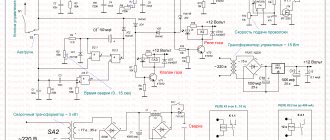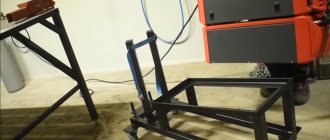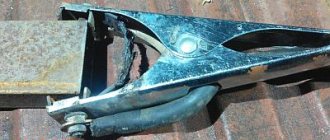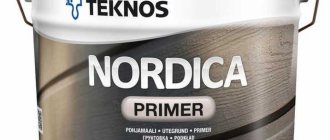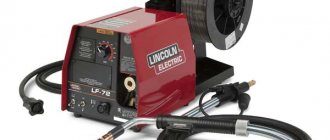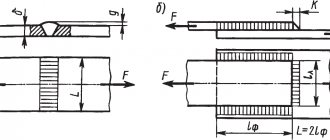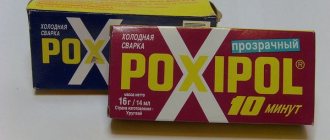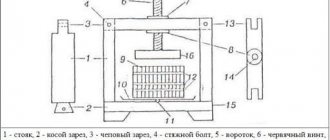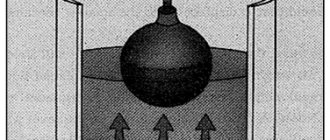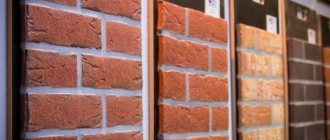Home / Devices
Back
Reading time: 2 min
0
5057
Nowadays, metal welding is performed using different techniques. Stores are overflowing with devices: transformers, inverters, rectifiers, semi-automatic devices and, of course, automatic machines.
They have serious differences. If any master can distinguish between a transformer and an inverter, then, without knowledge of the intricacies of these devices, the difference between a semi-automatic device and an automatic machine is not so clear.
Our publication will show in detail the difference between automatic and semi-automatic welding, and explain the superiority of the first over the second.
An automatic welding machine is a variation of a welding device; it is needed for automatic welding. No special skill is required here. It is enough to configure the equipment correctly, and it will do the rest itself.
An automatic welding machine is a complex technique, but be that as it may, it remains stable under significant loads. Fine adjustment affects the quality of the seams.
Since this method does not require direct participation in the welding procedure, the welder is called an operator.
An automatic welding machine performs several tasks simultaneously. They ignite the arc, make a seam, protect the welding space from exposure to oxygen (flux is used for this purpose), in addition, wire is fed into the welding bath.
- Advantages of automatic welding machine
- Difference between automatic and semi-automatic
- Why then use semi-automatic welding?
- conclusions
Advantages of automatic welding machine
The automatic welding machine has many advantages. One of them is the lack of the human factor. It can work for 24 hours with equally stable results. It is unlikely that any person will boast of such productivity.
It makes no difference to the machine which welding takes place. It copes equally with small elements with thin seams and with structures of significant dimensions. The machine will not get tired, it does not need sick leave, a break or a day off.
If the wizard makes a mistake with the parameters, this situation can be corrected without any problems. And if the master, due to, for example, physical or mental well-being, performs the work poorly, the workpiece will be rejected.
Options for using flux depending on the characteristics of steel
Based on the characteristics of the steel, it is determined which grade of flux should be used, for example:
- low-carbon or low-carbon steel - fluxes FC-9, AN-348A, OSTS-45 are used;
- high-alloy steels - FCL-2 flux is used;
- carbon and alloy steels - unfused ceramic flux KVS-19 or K-2 is required;
As for all other pipes, cold-drawn calibrated wire is usually used for welding.
The diameter of such welding wire is from 0.3 to 12 mm. However, the most commonly used section is from 0.8 mm to 5 mm. Its chemical composition may vary.
Difference between automatic and semi-automatic
The differences between automatic and semi-automatic are beyond doubt, although they have similar names and similar welding methods.
We have already said that the specialist himself manages the automatic welding. They set up the machine, and it carries out the entire welding procedure.
In this process, a person performs the function of an adjuster. He does not need to ignite the arc, conduct the seam or monitor the welding process. All he needs to do is select the welding mode and “order” the machine to perform it.
A completely different method is semi-automatic welding. Although it also uses filler wire, gas, flux and other raw materials, nevertheless, the welder does all the work, and not just setting up the machine.
That is, he runs the burner and forms the seam. Only the welding wire is fed automatically, hence the name “semi-automatic welding”.
Semi-automatic metal welding technique
The technology of joining metals using a semi-automatic installation is very important from the point of view of the quality of work. It is important to ensure that over time the seam does not lose its original characteristics. Working with a semi-automatic machine differs significantly from the technological features of using manual arc welding.
Below we discuss the basic methods and techniques for performing welding work using a semi-automatic machine.
Gas welding
If necessary, semi-automatic installations can use protective gas. This is necessary in order to cut off atmospheric air from the welding area and prevent oxidation of the seam. This approach significantly increases the strength of the welded joint.
Various inert gases are used for welding, but carbon dioxide and helium are most often in demand. The choice is determined by their relatively low cost and low consumption during the work process.
In the case of using carbon dioxide, it is important to achieve high quality preparation of the working surface. The more thoroughly the surface is cleaned, the less likely it is that dust, dirt, rust or paint residue will remain somewhere. Clean the edges with sandpaper, a wire brush or a grinder.
There are several technological methods for performing semi-automatic welding work in a protected environment:
- continuous welding . Requires skill and is one of the more difficult options. It is assumed that the torch passes from the beginning to the end of the weld without pauses or stops;
- automatic spot welding . The workpieces are connected using a large number of welded joints, made in the form of points, and not with a continuous seam;
- short circuit . Selected in most cases when it is necessary to connect two thin steel sheets. The metal is melted by pulses that are generated as a result of a provoked short circuit in the welding machine. The melt of two workpieces after cooling forms one structure.
When operating a semi-automatic installation in a protective gas environment, many experts prefer the alternating current mode. First of all, you need to correctly configure the equipment parameters, taking into account the type and thickness of the metal. Gas consumption is determined by the welding mode, and the wire is consumed at a rate of 4 cm per minute of working time. You can more accurately select the optimal settings using GOST tables.
After completing the preparatory work, you can begin welding. The gas supply is turned on, then the power is connected to initiate an electric arc (initiated by touching the wire to the surface of the workpiece). Then the start button is pressed, which turns on the mechanism for supplying consumables to the welding area.
To obtain a high-quality seam, it is necessary to take into account some very important nuances:
- The wire should be fed strictly straight, but not close to the seam. It is necessary to maintain an unobstructed view of the weld pool;
- a small gap is left between the edges of the workpieces being welded;
- The gap is determined depending on the thickness of the workpiece. 1 mm - if the product has walls about 1 cm thick. If the walls are thicker, then the gap should be approximately 10% of this value.
Aluminum processing technology
The semi-automatic machine has a wide range of capabilities, which allows you to weld different metals, including aluminum. Due to its special properties, special requirements must be adhered to in order to obtain a good result:
- On the surface of aluminum there is a thin layer of amalgam, the melting point of which is significantly higher than the metal itself. Therefore, a shielding gas is required for melting;
- Aluminum melts very quickly and has high fluidity. It is advisable to use a substrate that will avoid many unpleasant moments;
- For working with aluminum, reverse polarity mode with constant current is best suited. A positive charge is established on the burner, and a negative charge on the part.
By following these recommendations, the welder will quickly destroy the amalgam and obtain a good quality melt. As a result, a high-quality weld will be created.
Wire welding
The semi-automatic device allows you to work both in a gas environment and without it. You can weld the workpieces using submerged arc. But this option is more suitable for industry and is not very acceptable in everyday life due to the high cost of the flux. To understand the specifics of the method, you need to pay attention to the main characteristics of the flux - the powder placed in the middle part of the consumable.
It is not recommended to use self-shielding electrodes in combination with semi-automatic welding in cases where it is necessary to join thin sheets of metal or work with medium-carbon steel. Otherwise, the formation of defects – hot cracks – cannot be ruled out.
It is advisable to increase the arc temperature in order to achieve complete melting of the powder inside the protective electrode. This is achieved through reverse polarity.
Why then use semi-automatic welding?
Some novice specialists may ask this question after reading this article. It may seem that the benefits of automatic welding are beyond doubt.
It is less expensive and more productive. It also minimizes the possibility of a master error. However, let's talk about the details.
Most often they use semi-automatic welding. The use of automatic machines is necessary in a large enterprise. However, production on this scale is a rare area for welding.
As a rule, enterprises and workshops do not need to purchase such expensive equipment. It is easier to invite a specialist and use semi-automatic welding, since it is more reasonable to use it in small volumes.
The essence of the process and options
Automatic submerged arc welding, called in the international SAW system, is based on the burning of an electric arc that melts the edges of the metal. To do this, a wire (GOST 16130-72 or with other compositions) is fed into the welding zone, and an arc is excited between the tip of which and the product. The welding tractor, in parallel with this, supplies a special powder to the joint zone - flux, which covers the molten part of the seam, protecting it from the effects of external gases. Additionally, the flux layer promotes better fusion of alloying elements into the seam structure and reduces metal spattering.
The melting end of the wire is held by the head of the welding machine at a certain distance from the product. The welding machine can work stationary when it is used to weld pipes that rotate on rollers driven by a gearbox. Or the head of the device can move along a given path, thanks to the presence of a template corresponding to the shape of the connection. The installation operator only sets the welding modes and starts the process. Automatic submerged arc welding technology requires human control over the work and adjustment of modes, as well as periodic assessment of the quality of the result. Models called welding tractors move independently on their own chassis along the welding line. All the main components of such a machine move with it.
According to GOST 8713-79, the following types of work that a welding machine can perform are distinguished:
- weld products by weight, without supports for the reverse side of the seam;
- on a special copper lining that protects against leaks and sagging;
- on a cushion of powder;
- on a copper slide that accompanies the movement of the apparatus head.
In some cases, it is necessary to apply a preliminary root seam along which the welding tractor will carry out its work. In other technologies, it is necessary to produce welding seams on the reverse side of the product.
https://www.youtube.com/watch?v=elCSbt438e0
conclusions
Automatic welding machines and semi-automatic welding machines have a lot in common. What is different is the automation of the welding procedure. During semi-automatic welding, the specialist independently ignites the arc and forms the seam.
The intervention of the master is not required only when feeding the wire into the welding area. And with an automatic welding procedure, the welding procedure is performed automatically; the technician just needs to enter the required configuration. The device will perform other procedures itself.
Now you know the nuances of automatic and semi-automatic welding, the differences between these two methods and situations when automatic welding cannot be used.
Types of automatic devices
Based on their design solutions, automatic welding equipment is divided into several types:
- Tractor type. For work under a layer of flux or in an environment of protective gases.
- Suspended welding machine. For use in protective gas environments.
- Multi-arc device. There are modifications of both tractor and suspended versions.
Tractor type
The first type of devices was developed and released in the USSR. Design requirements are regulated by GOST 8213-69. Widely used in heavy industry.
Welding tractor
As an example, consider the design of a single-engine tractor of the TS-17-R type. As the name suggests, the tractor has only one electric motor. It is designed to perform work under a layer of flux when welding various butt seams. In this case, the minimum radius of circumferential seams is 600 mm.
An electric motor drives the running mechanism and the wire feeder. All three elements have a common body, which is the supporting structure of the tractor. It serves as a support for other mechanisms: the flux loading hopper, the wire drum and the control unit.
The electrode is located near the vertical axis, which passes through the center of gravity. This feature allows you to work inside containers: the low center of gravity provides increased stability.
Overhead welding machine
Suspended type equipment consists of the following basic elements:
- Feeding device.
- Drive caliper.
- Vertical movement mechanism.
- Flux bunker.
- Wire drum.
- Control block.
Overhead welding machine
Suspended equipment is divided into stationary and self-propelled units.
Stationary devices are distinguished by the fact that before starting work they are installed in the selected location and are not moved until the work is completed. The main area of application is pipe connection. Self-propelled vehicles are equipped with a trolley for moving around the work site. They are distinguished by their ability to create permanent connections of considerable length.
Application of welding method
Automatic arc welding complies with the parameters of GOST 8713-79. Due to its high operating speed, it is successfully used for applying smooth seams in a longitudinal position. To ensure direct movement of the head, the welding machine is equipped with templates, along the edge of which the electrode wire moves and the arc burns. This method quickly joins thick sheets of iron used for industrial structures. Curly movements of the head of the apparatus are also possible. To do this, install the appropriate template.
Welding tractors for submerged arc welding are capable of performing all seams specified by GOST 11533-75. They are well suited for butt, lap, corner and T joints. The weld is smooth and well-melted, without excessive consumption of filler material.
Where it is necessary to lay a pipeline, automatic welding of circumferential seams is especially successfully used. The essence of the method is to rotate the product under the stationary head of the welding machine. Thanks to the increased current, work is carried out faster than in manual mode. The seams are of high quality. Automatic pipe welding can be carried out over a large area, connecting sections into one line. The size of such blanks reaches 25 meters. Large connections are also possible, but this depends on the possibility of transporting the pipe to the installation site. Additionally, tractors or railway equipment are used. Using a crane, the pipes are laid into the main, and the final butt weld is performed by a welder manually. This significantly speeds up the process of laying pipelines.
Advantages of the automatic method
A welding machine operating in automatic mode has a number of advantages over other types of welding. Namely:
- high productivity of work due to increased current strength and speed of welding, which can exceed other methods by 15 times;
- good connection quality due to the stability of the additive supply and the constant speed of passage of the entire line;
- deep penetration;
- working with large diameter pipes;
- using fewer welders for the same amount of work;
- more favorable working conditions for the welder and less harm to health, due to the distance from the source of radiation and smoke.
Fast modes of automatic submerged arc welding are also achieved through the use of powder, which is supplied to the arc combustion zone from a special hopper through a tube. The amount of rash is regulated by the opening width of the damper. Externally, the flux looks like round light balls, finely granulated. Fluxing the welding area has the following advantages:
- eliminates splashing of the metal of the weld pool and filler element;
- gives stability to the arc;
- delays the cooling process of the weld, which improves its physical properties;
- protects the weld pool from the interaction of molten metal with oxygen;
- deoxidizes the metal and helps the alloying elements to be fused better.
The welding tractor melts part of the powder with an electric arc from the wire, as a result of which a small crust forms on the surface of the joint. The other part of the powder remains in the form of granules. After completing the seam, it is necessary to remove the slag layer with a hammer and a metal brush. The cleaned product is ready for painting or treatment with anti-corrosion compounds.
